Takahiro Komamizu
MultiSensor-Home: A Wide-area Multi-modal Multi-view Dataset for Action Recognition and Transformer-based Sensor Fusion
Apr 03, 2025Abstract:Multi-modal multi-view action recognition is a rapidly growing field in computer vision, offering significant potential for applications in surveillance. However, current datasets often fail to address real-world challenges such as wide-area environmental conditions, asynchronous data streams, and the lack of frame-level annotations. Furthermore, existing methods face difficulties in effectively modeling inter-view relationships and enhancing spatial feature learning. In this study, we propose the Multi-modal Multi-view Transformer-based Sensor Fusion (MultiTSF) method and introduce the MultiSensor-Home dataset, a novel benchmark designed for comprehensive action recognition in home environments. The MultiSensor-Home dataset features untrimmed videos captured by distributed sensors, providing high-resolution RGB and audio data along with detailed multi-view frame-level action labels. The proposed MultiTSF method leverages a Transformer-based fusion mechanism to dynamically model inter-view relationships. Furthermore, the method also integrates a external human detection module to enhance spatial feature learning. Experiments on MultiSensor-Home and MM-Office datasets demonstrate the superiority of MultiTSF over the state-of-the-art methods. The quantitative and qualitative results highlight the effectiveness of the proposed method in advancing real-world multi-modal multi-view action recognition.
MultiTSF: Transformer-based Sensor Fusion for Human-Centric Multi-view and Multi-modal Action Recognition
Apr 03, 2025Abstract:Action recognition from multi-modal and multi-view observations holds significant potential for applications in surveillance, robotics, and smart environments. However, existing methods often fall short of addressing real-world challenges such as diverse environmental conditions, strict sensor synchronization, and the need for fine-grained annotations. In this study, we propose the Multi-modal Multi-view Transformer-based Sensor Fusion (MultiTSF). The proposed method leverages a Transformer-based to dynamically model inter-view relationships and capture temporal dependencies across multiple views. Additionally, we introduce a Human Detection Module to generate pseudo-ground-truth labels, enabling the model to prioritize frames containing human activity and enhance spatial feature learning. Comprehensive experiments conducted on our in-house MultiSensor-Home dataset and the existing MM-Office dataset demonstrate that MultiTSF outperforms state-of-the-art methods in both video sequence-level and frame-level action recognition settings.
Action Selection Learning for Multi-label Multi-view Action Recognition
Oct 04, 2024
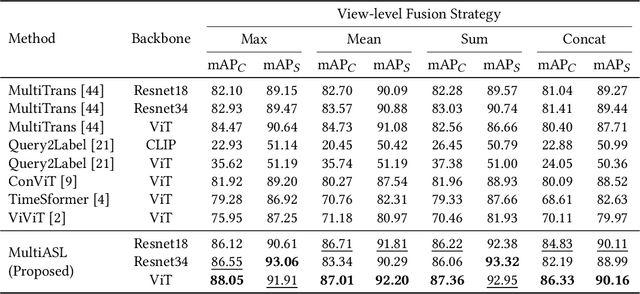
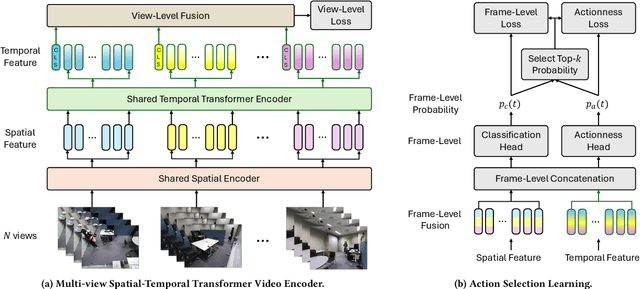

Abstract:Multi-label multi-view action recognition aims to recognize multiple concurrent or sequential actions from untrimmed videos captured by multiple cameras. Existing work has focused on multi-view action recognition in a narrow area with strong labels available, where the onset and offset of each action are labeled at the frame-level. This study focuses on real-world scenarios where cameras are distributed to capture a wide-range area with only weak labels available at the video-level. We propose the method named MultiASL (Multi-view Action Selection Learning), which leverages action selection learning to enhance view fusion by selecting the most useful information from different viewpoints. The proposed method includes a Multi-view Spatial-Temporal Transformer video encoder to extract spatial and temporal features from multi-viewpoint videos. Action Selection Learning is employed at the frame-level, using pseudo ground-truth obtained from weak labels at the video-level, to identify the most relevant frames for action recognition. Experiments in a real-world office environment using the MM-Office dataset demonstrate the superior performance of the proposed method compared to existing methods.
Tracking Small Birds by Detection Candidate Region Filtering and Detection History-aware Association
May 27, 2024Abstract:This paper focuses on tracking birds that appear small in a panoramic video. When the size of the tracked object is small in the image (small object tracking) and move quickly, object detection and association suffers. To address these problems, we propose Adaptive Slicing Aided Hyper Inference (Adaptive SAHI), which reduces the candidate regions to apply detection, and Detection History-aware Similarity Criterion (DHSC), which accurately associates objects in consecutive frames based on the detection history. Experiments on the NUBird2022 dataset verifies the effectiveness of the proposed method by showing improvements in both accuracy and speed.
One-Stage Open-Vocabulary Temporal Action Detection Leveraging Temporal Multi-scale and Action Label Features
Apr 30, 2024



Abstract:Open-vocabulary Temporal Action Detection (Open-vocab TAD) is an advanced video analysis approach that expands Closed-vocabulary Temporal Action Detection (Closed-vocab TAD) capabilities. Closed-vocab TAD is typically confined to localizing and classifying actions based on a predefined set of categories. In contrast, Open-vocab TAD goes further and is not limited to these predefined categories. This is particularly useful in real-world scenarios where the variety of actions in videos can be vast and not always predictable. The prevalent methods in Open-vocab TAD typically employ a 2-stage approach, which involves generating action proposals and then identifying those actions. However, errors made during the first stage can adversely affect the subsequent action identification accuracy. Additionally, existing studies face challenges in handling actions of different durations owing to the use of fixed temporal processing methods. Therefore, we propose a 1-stage approach consisting of two primary modules: Multi-scale Video Analysis (MVA) and Video-Text Alignment (VTA). The MVA module captures actions at varying temporal resolutions, overcoming the challenge of detecting actions with diverse durations. The VTA module leverages the synergy between visual and textual modalities to precisely align video segments with corresponding action labels, a critical step for accurate action identification in Open-vocab scenarios. Evaluations on widely recognized datasets THUMOS14 and ActivityNet-1.3, showed that the proposed method achieved superior results compared to the other methods in both Open-vocab and Closed-vocab settings. This serves as a strong demonstration of the effectiveness of the proposed method in the TAD task.
MVA2023 Small Object Detection Challenge for Spotting Birds: Dataset, Methods, and Results
Jul 18, 2023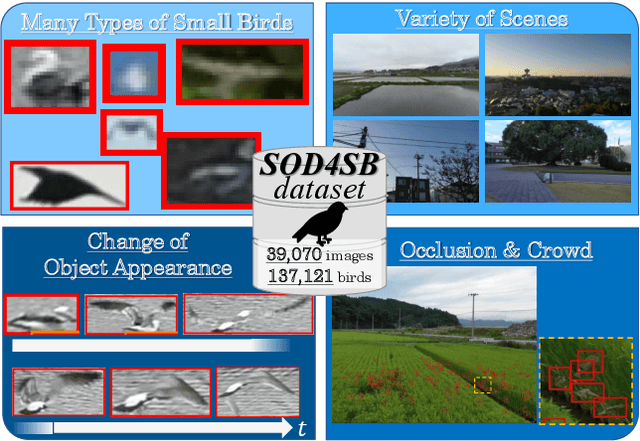

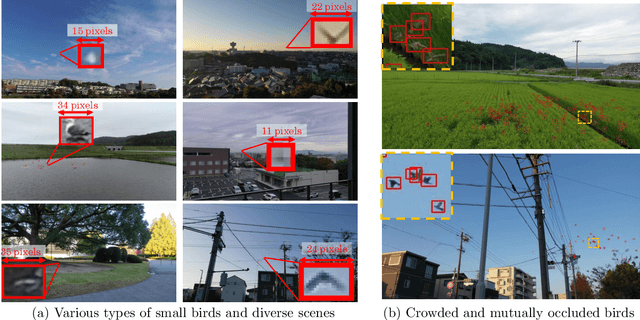
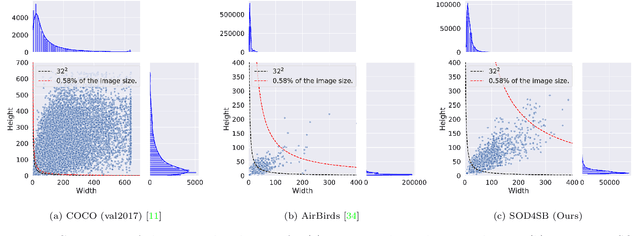
Abstract:Small Object Detection (SOD) is an important machine vision topic because (i) a variety of real-world applications require object detection for distant objects and (ii) SOD is a challenging task due to the noisy, blurred, and less-informative image appearances of small objects. This paper proposes a new SOD dataset consisting of 39,070 images including 137,121 bird instances, which is called the Small Object Detection for Spotting Birds (SOD4SB) dataset. The detail of the challenge with the SOD4SB dataset is introduced in this paper. In total, 223 participants joined this challenge. This paper briefly introduces the award-winning methods. The dataset, the baseline code, and the website for evaluation on the public testset are publicly available.
IPA-CLIP: Integrating Phonetic Priors into Vision and Language Pretraining
Mar 06, 2023Abstract:Recently, large-scale Vision and Language (V\&L) pretraining has become the standard backbone of many multimedia systems. While it has shown remarkable performance even in unseen situations, it often performs in ways not intuitive to humans. Particularly, they usually do not consider the pronunciation of the input, which humans would utilize to understand language, especially when it comes to unknown words. Thus, this paper inserts phonetic prior into Contrastive Language-Image Pretraining (CLIP), one of the V\&L pretrained models, to make it consider the pronunciation similarity among its pronunciation inputs. To achieve this, we first propose a phoneme embedding that utilizes the phoneme relationships provided by the International Phonetic Alphabet (IPA) chart as a phonetic prior. Next, by distilling the frozen CLIP text encoder, we train a pronunciation encoder employing the IPA-based embedding. The proposed model named IPA-CLIP comprises this pronunciation encoder and the original CLIP encoders (image and text). Quantitative evaluation reveals that the phoneme distribution on the embedding space represents phonetic relationships more accurately when using the proposed phoneme embedding. Furthermore, in some multimodal retrieval tasks, we confirm that the proposed pronunciation encoder enhances the performance of the text encoder and that the pronunciation encoder handles nonsense words in a more phonetic manner than the text encoder. Finally, qualitative evaluation verifies the correlation between the pronunciation encoder and human perception regarding pronunciation similarity.
 Add to Chrome
Add to Chrome Add to Firefox
Add to Firefox Add to Edge
Add to Edge